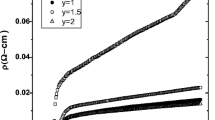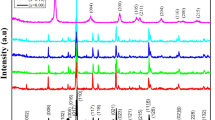Abstract
This research carried out experiments on the superconducting compound HgBa2Can−1CunO2n+2+δ at n = 2, 3. The samples were prepared using a sealed quartz tube. XRD analyses were used to determine the crystal structure and their parameters for both Hg-1212 and Hg-1223. Many software packages were used to refine and simulate the crystal structures. It was clear that the final phase in all cases was a tetragonal phase with a space group symmetry P4/mmm (123), and shrinkage along the c-axis of about 0.2 from the theoretical value. There was a slight variation in the basal plane axis and a sharp increase in the c-axis as a function of n. The presence of an octahedron structure within the unit cell is the origin of the charge reservoir, and increasing the number of octahedrons per unit cell is the reason to increase the concentration of the electronic charges per unit cell. Iodometric titration was done to show the excessive oxygen content, during the creating of tetrahedron structures. The last reason is to determine the amount of oxygen insertion within the structure. Resistivity measurement was necessary in order to determine the critical temperatures and related resistivity, creating the correlation with Miller indices and lattice constants. At the same time, the tetrahedrons are the main topics in developing the conductivity. It was clear from the electrical resistivity that the critical temperatures were 115 and 125 K for Hg-1212 and Hg-1223, respectively. These critical temperatures were in agreement with the data from the vibrating sample magnetometer (VSM). There were magnetic susceptibilities in both phases, i.e., χ = − 0.25 × 10−2 and − 0.41 × 10−2 for the Hg-1212 and Hg-1223 phases, respectively. It was concluded that many parameters were related to the conductivity and magnetic susceptibility of both phases. The induced magnetic field is 99.75% for n = 2, and 99.59% for n = 3. This result is in agreement with the results of penetration depth for both systems that showed greater value for n = 3 than for n = 2.




Similar content being viewed by others
References
Schilling, A., Cantoni, M., Guo, J.D., Ott, H.R.: Superconductivity above 130 K in the Hg-Ba-Ca-Cu-O system. Nature. 363, 56–58 (1993)
Putilin, S.N., Antipov, E.V., Chmaissem, O., Marezio, M.: Superconductivity at 94 K in HgBa2CuO4+δ. Nature. 362, 226–228 (1993)
Gao, L., Xue, Y.Y., Chen, F., Xiong, Q., Meng, R.L., Ramirez, D., Chu, C.W., Eggert, J.H., Mao, H.K.: Superconductivity up to 164 K in HgBa2Cam-1CumO2m+2+δ (m=1,2, and 3) under quasihydrostatic pressures. Phys Rev B. 50(6), 4260–4263 (1994)
Babych, O., Boyko, Y., Gabriel, I., Lutciv, R., Matviyiv, M., Vasyuk, M.: Preparation and properties of doped Hg-based superconducting copper oxides. Acta Phys Pol A. 117(1), 27–29 (2010)
Tendeloo, G.V., Chaillout, C., Capponi, J.J., Marezio, M., Antipov, E.V.: Atomic structure and defect structure of the superconducting HgBa2Can-1CunO2n+2+δ homologous series. Physica C. 223, 219–226 (1994)
Chmaissem, O., Jorgensen, J.D., Hinks, D.G., Storey, B.G., Dabrowski, B., Zhang, H., Marks, L.D.: Structure and superconductivity in Cr-substituted HgBa2CuO4+δ. Physica C. 279, 1–10 (1997)
Roeser, H.P., Bohr, A., Haslam, D.T., Lόpez, J.S., Stepper, M., Huber, F.M., Nikoghosyan, A.S.: Correlation between crystal structure and resistivity of high-temperature superconducting cuprates. Armenian J Phys. 4(2), 109–133 (2011)
Chen, X., Xu, Z., Wang, J., Jiao, Z., Zhang, Q.: Oxidation state of copper and superconductivity in the Hg-Ba-Ca-Cu-O system. Chem Phys Lett. 258, 1–5 (1996)
Lutciv, R.V., Boyko, Y.V.: Extra oxygen and carrier distribution in CuO2 layers in HgBa2Can-1Cun O2n+2+δ compounds (n=1,2,4). Condens Matter Phys. 2(3), 481–486 (1999)
Roeser, H.P., Haslam, D.T., López, J.S., Stepper, M., Schoenermark, M.F., Huber, F.M., Nikoghosyan, A.S.: Electronic energy levels in high-temperature superconductors. J Supercond Nov Magn. 24, 1443–1451 (2011)
D.A. Pavlov, Synthesis and properties of substituted Hg-based superconductors, Ph.D. Thesis, Department of Inorganic Chemistry, Stockholm University, (2004)
Chu, C.W., Deng, L.Z., Lv, B.: Hole-doped cuprate high temperature superconductors. Physica C. 514, 290–313 (2015)
Xue, Y.Y., Hor, P.H., Meng, R.L., Tao, Y.K., Sun, Y.Y., Huang, Z.J., Gao, L., Chu, C.W.: Structural stability and doping in R2CuO4 (R = rare-earth). Physica C. 165, 357–363 (1990)
Wu, J.Z.: What have we learnt from the highest-Tc superconducting Hg-based cuprates? Physica C. 493, 96–99 (2013)
Putilin, S.N., Antipov, E.V., Marezio, M.: Superconductivity above 120 K in HgBa2CaCu2O6+δ. Physica C. 212, 266–270 (1993)
Phillips, J.C.: Resonant pinning, supercell structure, and superconductivity (Tc> 140 K) in Hg-Ba-Ca-Cu-O systems. Mater Lett. 18, 106–107 (1993)
Obertelli, S.D., Cooper, J.R., Talion, J.L.: Systematics in the thermoelectric power of high-Tc oxides. Phys Rev B. 46(22), 14928–14931 (1992)
Hamoodi, A.I., Al-Shakarchi, E.K., Elouadi, B.: Superconductor Materials Hg-Family and Bi-Family. Lambert Academic Publishing (2014)
Correia, J.G., Araujo, J.P., Loureiro, S.M., Toulemonde, P., Le Floch, S., Bordet, P., Capponi, J.J., Gatt, R., Troger, W., Ctortecka, B., Butz, T., Haas, H., Marques, J.G., Soares, J.C.: Local Oδ probing in the high-Tc superconductor HgBa2CuO4+δ. Phys Rev B. 61(17), 11769–11775 (2000)
Kareiva, A., Barkauskas, J., Mathur, S.: Oxygen content and superconducting properties of Hg-based superconductors synthesized by sol–gel method. J Phys Chem Solids. 61(5), 789–797 (2000)
Goodenough, J.B., Manthiram, A.: Crystal chemistry and superconductivity of the copper oxides. J Solid State Chem. 88(1), 115–139 (1990)
Lokshin, K.A., Pavlov, D.A., Kovba, M.L., Putilin, S.N., Antipov, E.V., Bryntse, I.: Synthesis and investigation of (Hg1−xCux)Ba2Ca2Cu3O8+δ. Physica C. 366(4), 263–269 (2002)
Omar, M.A.: Elementary Solid State Physics: Principles and Applications. Addison-Wesley Publishing Company (1975)
Acknowledgments
Finally, it is our great pleasure to thank Prof. Dr. B. Elouadi from La Rochelle University in France for his advice and providing the required facilities that were used at La Rochelle University and other universities in France, especially in terms of the magnetic susceptibility needed to complete the requirement of this research project.
Author information
Authors and Affiliations
Corresponding author
Additional information
Publisher’s Note
Springer Nature remains neutral with regard to jurisdictional claims in published maps and institutional affiliations.
Rights and permissions
About this article
Cite this article
Al-Shakarchi, E.K., Al-Janabi, A.I. The Conductivity Mechanism in an Hg-Ba-Ca-Cu-O High-Tc Superconductor. J Supercond Nov Magn 33, 379–385 (2020). https://doi.org/10.1007/s10948-019-05220-7
Received:
Accepted:
Published:
Issue Date:
DOI: https://doi.org/10.1007/s10948-019-05220-7




